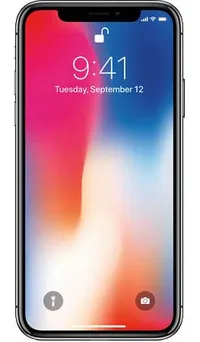iPhone X vs. Galaxy S8: Which Flagship Phone Wins?
The iPhone X dazzles with its new OLED display and Face ID, but the cheaper Galaxy S8 delivers a lot for your money.
Yeah, the $950 Galaxy Note 8 is technically a closer competitor to the $999 iPhone X because of the Note's higher price tag, but don't overlook the Galaxy S8 ($750) and S8+ ($850).
The Galaxy S8's display is the same size as the iPhone X's, at 5.8 inches, and both screens use OLED technology for eye-popping colors and ultrawide viewing angles. The 6.2-inch Galaxy gives you an even bigger screen than the iPhone X but still costs less dough.
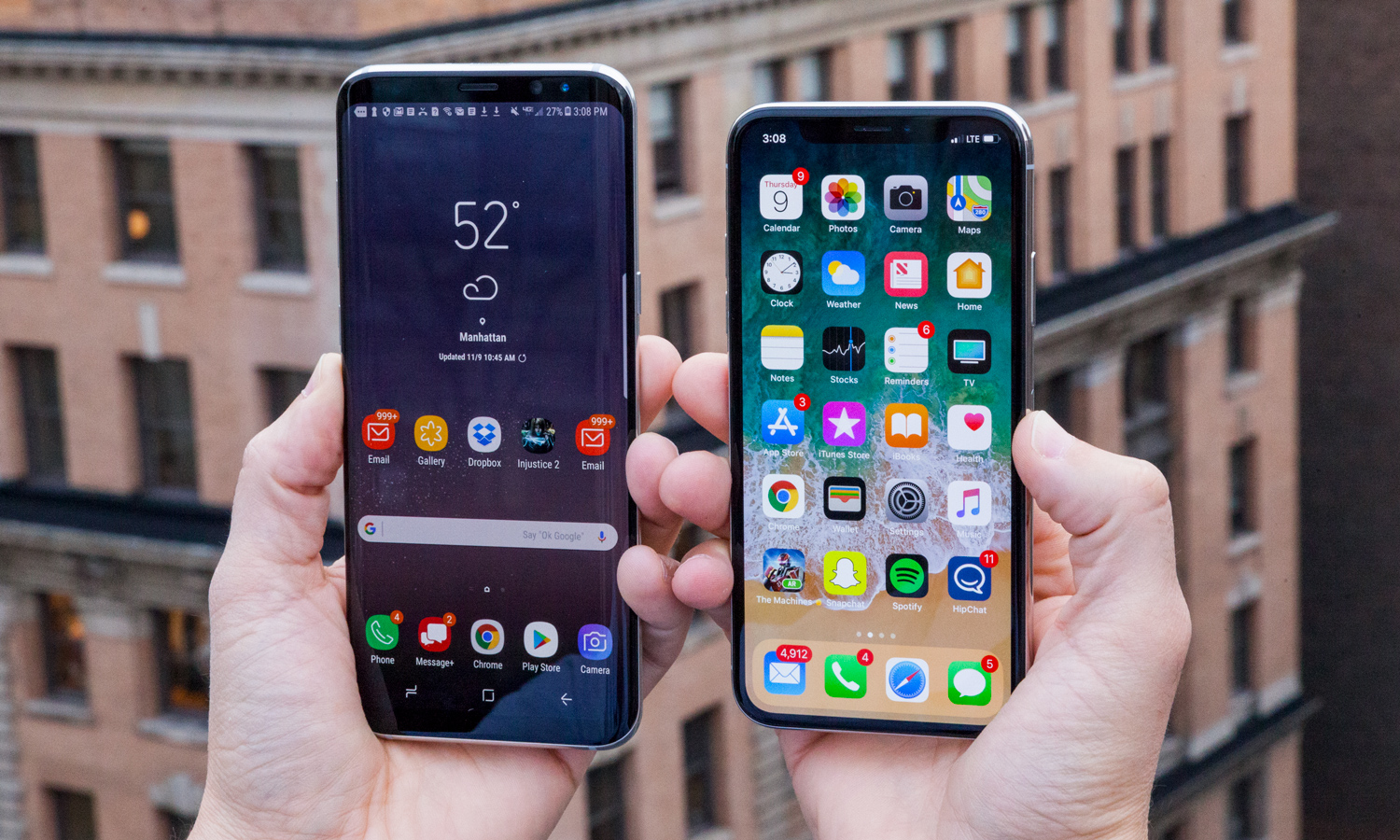
But the iPhone X has some secret weapons of its own, including an all-new design, dual rear cameras, Face ID and a superfast A11 Bionic processor. Which phone is right for you? Read on.
iPhone X vs Galaxy S8 vs Galaxy S8+: Specs Compared
| iPhone X | Galaxy S8 | Galaxy S8+ | |
| Price | $999 | $750 | $850 |
| Display | 5.8 inches (2436 x 1125) Super Retina | 5.8 inches (2960 x 1440) | 6.2 inches (2960 x 1440) |
| Rear Camera | Dual 12-MP (f/1.8, f/2.4) | 12-MP (f/1.7) | 12-MP (f/1.7) |
| Front Camera | 7-MP TrueDepth | 8-MP (f/1.7) | 8-MP (f/1.7) |
| CPU | A11 Bionic | Snapdragon 835 | Snapdragon 835 |
| RAM | 3GB | 4GB | 4GB |
| Storage | 64GB, 256GB | 64GB (microSD) | 64GB (microSD) |
| Battery Life | 10:49 | 10:39 | 11:04 |
| Dimensions | 5.7 x 2.8 0.3 inches | 5.9 x 2.7 x 0.3 inches | 6.3 x 2.9 x 0.3 inches |
| Weight | 6.1 ounces | 5.5 ounces | 6.1 ounces |
Design
There's no question that the Galaxy S8 and iPhone X are two of the most beautiful phones of the year. The iPhone X has a near edge-to-edge screen up front and an elegant glass back available in Silver and Space Gray. The stainless-steel band that runs along the outside of the phone really pops while giving the handset a very sturdy feel.
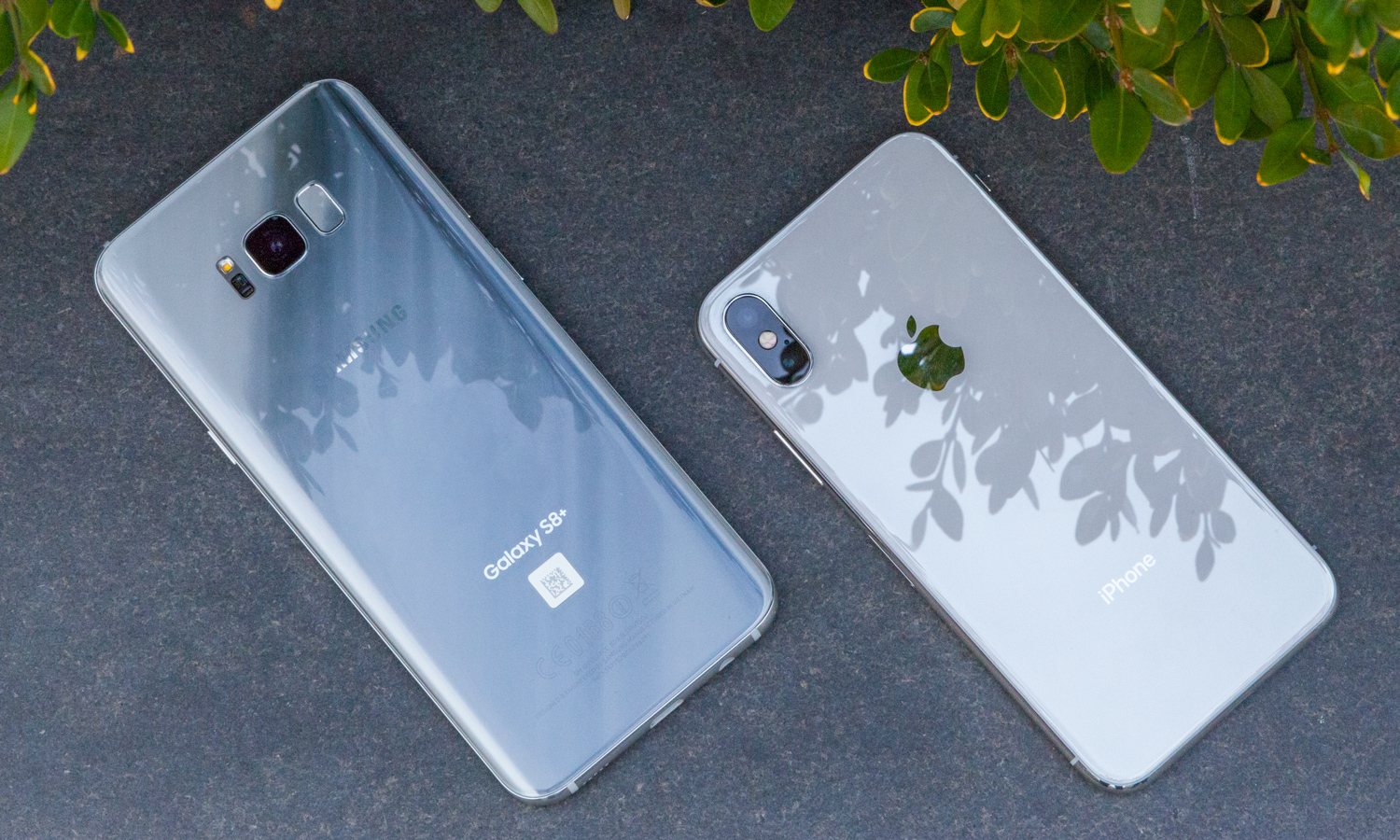
The Galaxy S8's Infinity Display is even sexier, though, as it's curved and doesn't have a notch that interrupts the flow of the front of the phone, which the iPhone X has. Both the S8 and iPhone X are water-resistant, but only Samsung's phone includes a headphone jack and microSD card slot.
Lastly, at 5.5 ounces, the S8 is a little lighter than the 6.1-ounce iPhone X. In fact, the S8+ weighs the same as the iPhone X, even though the S8+ has a bigger, 6.2-inch screen. The S8+ is taller, though, which makes it more of a stretch for one-hand use.
MORE: iPhone X Review: All Your Questions Answered
Get instant access to breaking news, the hottest reviews, great deals and helpful tips.
Winner: Galaxy S8 and S8+
Display
Samsung has long been the leader in OLED screens for phones, but it's now been leapfrogged. In side-by-side tests, the iPhone X's (2436 x 1125) panel delivered a brighter image, wider viewing angles and better contrast than the displays on the S8 and S8+ (both 2960 x 1440 pixels).
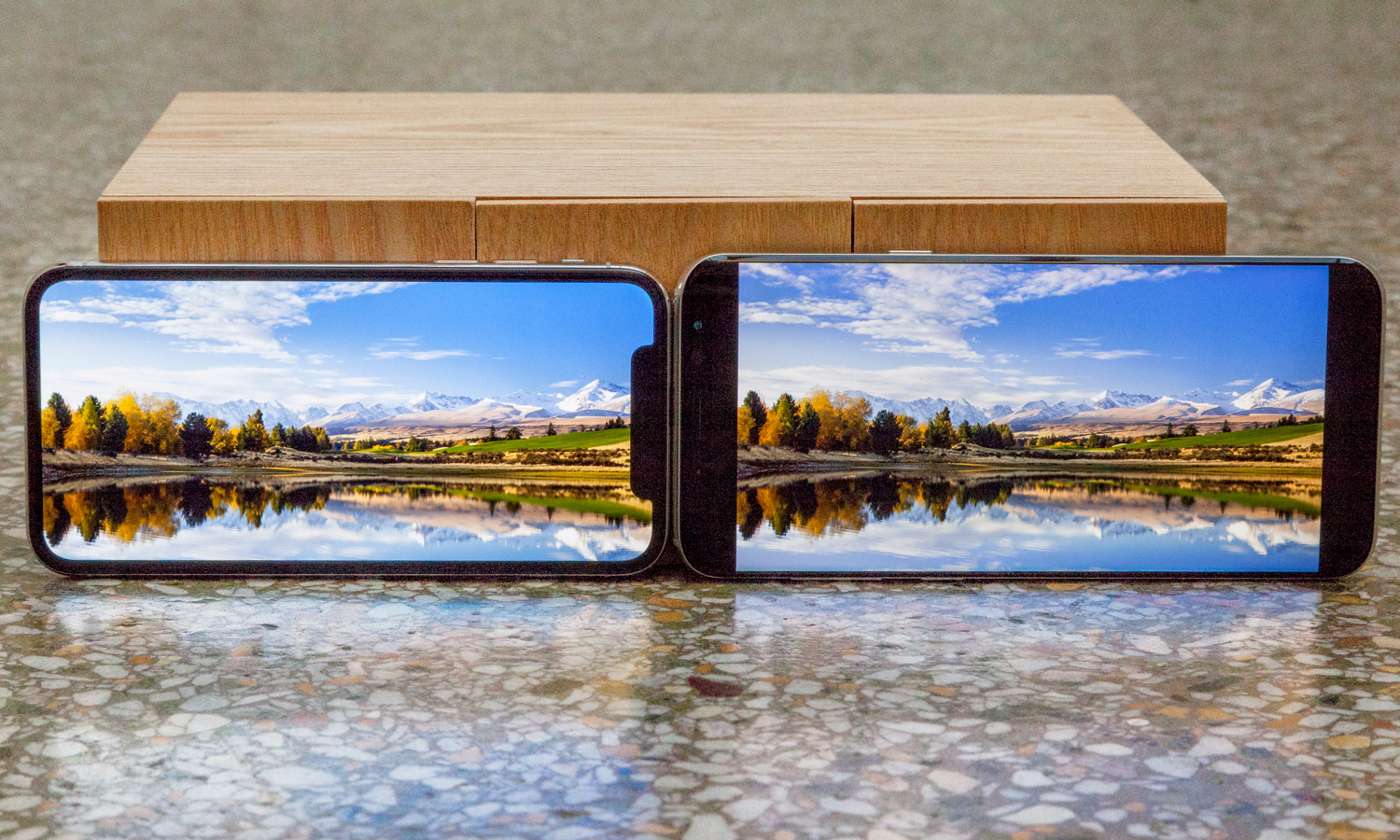
Take this photo of a lake and surrounding mountains. On the Galaxy S8 and S8+, the sky is a deeper blue, but the iPhone X's display delivers a more-vibrant green grass and truer whites in the clouds. The clouds in the S8+'s screen look more magenta.
MORE: iPhone X Is King of OLED Screens: See for Yourself
In addition, the brighter panel on the iPhone X gives it wider viewing angles. Under normal, indoor conditions, the iPhone X hit 574 nits, compared to 543 nits for the S8 and 475 nits for the S8+.
The displays on the S8 and S8+ do cover more of the sRGB color gamut, exceeding 180 percent, versus 123 percent for the iPhone X.
Winner: iPhone X
Cameras
Given that the iPhone X has dual rear cameras and the S8 has a single shooter, you would think this wouldn't be a fair fight. But that's not the case. Samsung's phone more than held its own when pitted against Apple's flagship.
The S8 got off to a great start with this photo of the Flatiron Building on a mostly overcast day. Its camera revealed a lot more detail in the building, while the iPhone X's shot looks drab and flat.
But the iPhone X pulled ahead when I photographed two colleagues. The iPhone's photo of Cortney and Andrew delivered warmer skin tones, while they look more washed out in the S8 image.
The iPhone X also excelled on our zoom test, but that's not a surprise given the phone's dual-lens setup. The S8 gets by with a single lens, so its 2x digital zoom photo of the Empire State Building turned out fuzzier.
It's a subtle difference, but the iPhone X offered richer pinks and more gradation of color in this close-up shot of a plumed cockscomb plant, but the S8 shot is just about as sharp.
This Galaxy S8 pulled ahead indoors, including in a photo of this Lego Man. His face is brighter on the S8 shot than on the iPhone X.
The S8 also let in more light than the iPhone X did on this shot of a raccoon decoration, and the colors look more natural.
Last but not least, the iPhone X had a slight edge on this flash shot, as the Apple phone's colors look a little warmer and more natural. The Galaxy S8 does a better job of rendering the flowers up front, but the image looks cooler and bluer overall.
To test the front cameras on the iPhone X and Galaxy S8, I took a selfie outdoors,and the difference was pretty much night and day. The S8 offers a wider angle, so you can fit more people in the frame, but the iPhone X did a better job capturing the warmer skin tone of my face and the more vibrant reds and blues in my shirt.
Winner: iPhone X
Performance
Put simply, the A11 Bionic processor inside the iPhone X is in a whole other league compared to the Snapdragon 835 chip in the Galaxy S8.

Take something as routine as loading up a new level in Injustice 2, a fighting game. In just 9 seconds, the iPhone X had us throwing punches as Batman, compared to a 13-second wait on the Galaxy S8.
MORE: iPhone X Is World's Fastest Phone (It's Not Even Close)
We also edited a 4K video clip using the Adobe Clip app, on which we saw a bigger performance difference. The iPhone X took just 43 seconds, compared to over 4 minutes for the Galaxy S8.
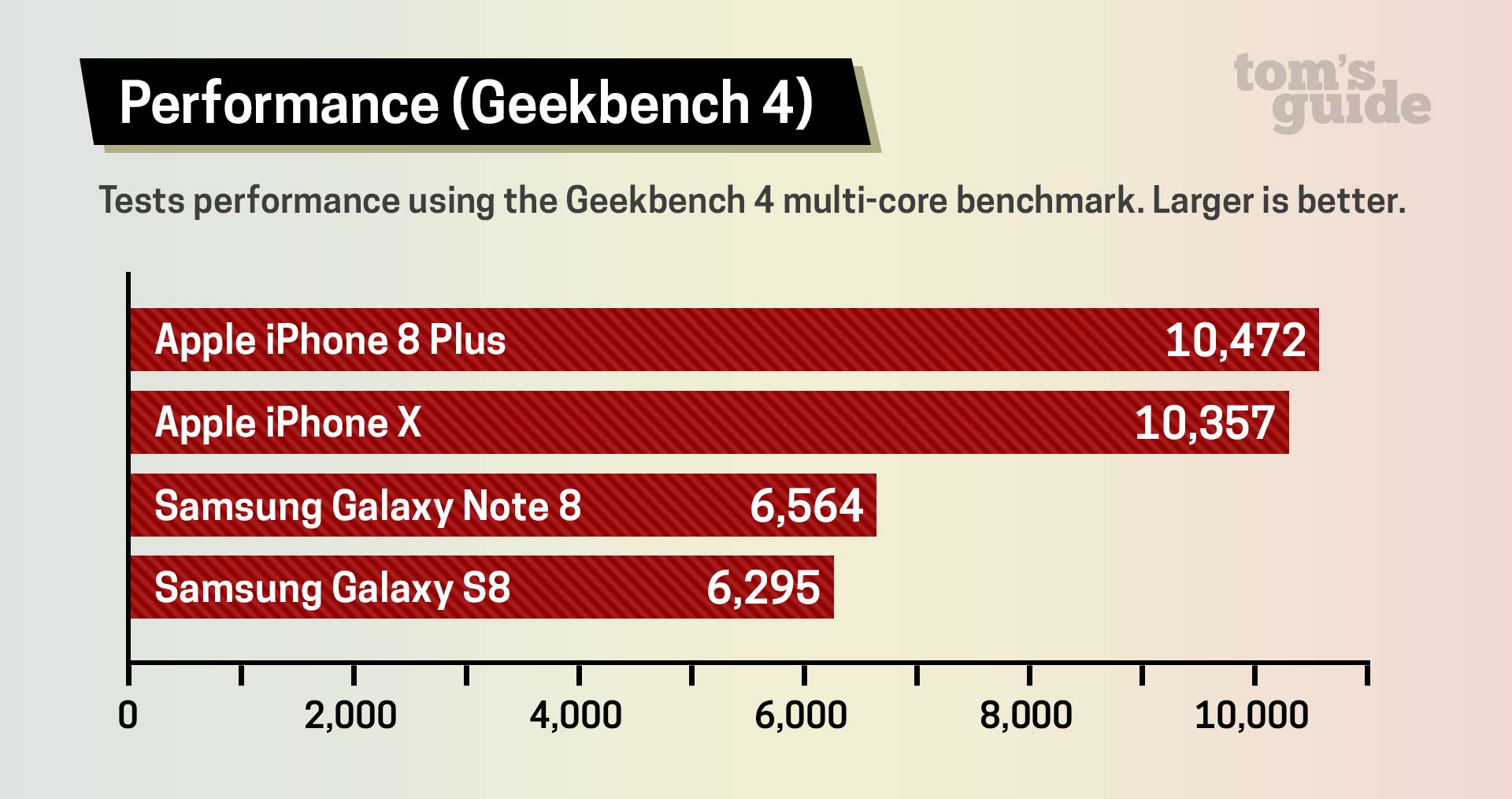
It was a similar story on synthetic benchmarks like Geekbench 4, where the iPhone X notched a very high score of 10,357 versus 6,295 for the S8.
Winner: iPhone X
Special Features
The iPhone X does facial recognition right with Face ID, which uses the TrueDepth camera to create a 3D map of your face to unlock the device. The S8 has facial recognition, but it's 2D and doesn't work well in the dark. The S8 also offers iris scanning that also works well in the dark, but having two technologies to do one thing seems like overkill.
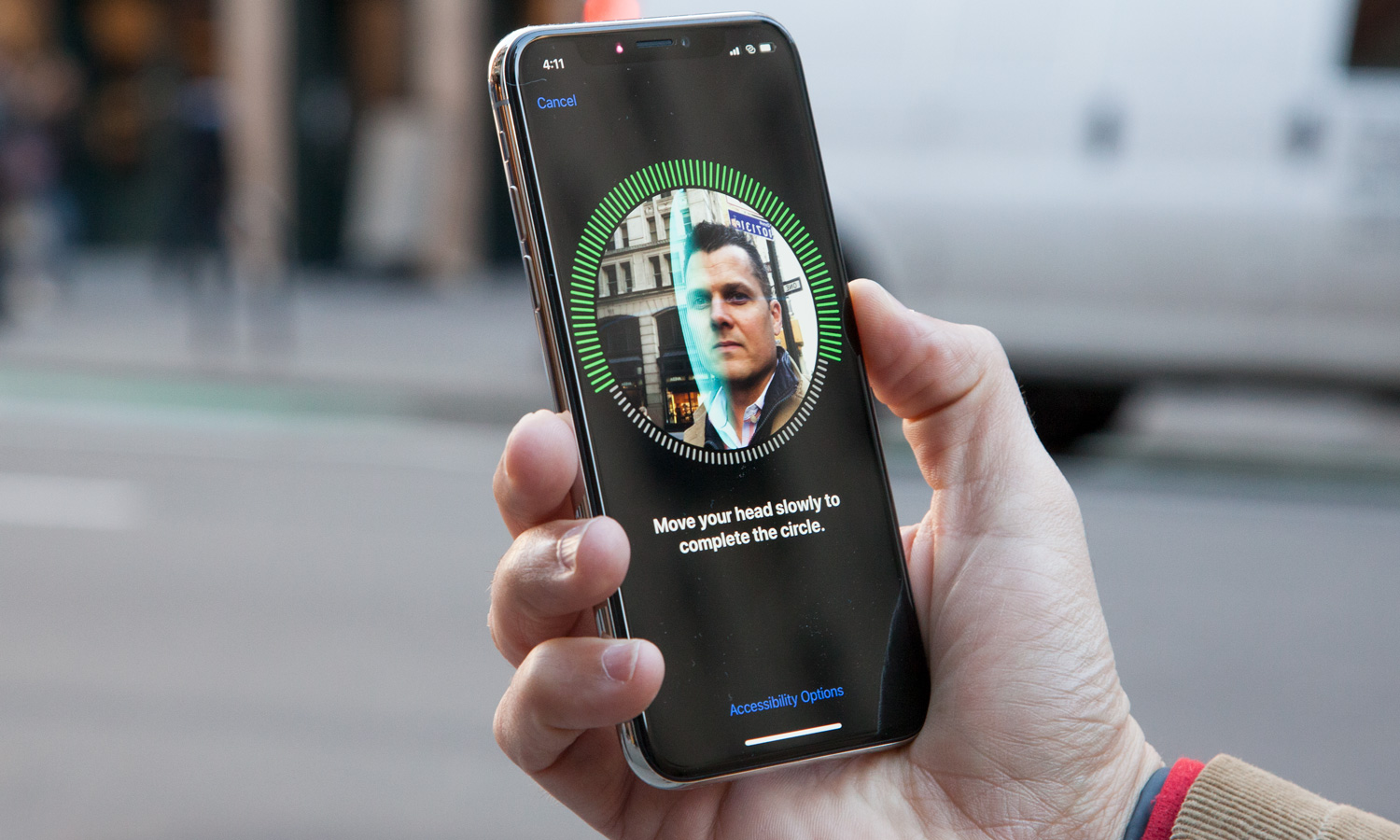
The TrueDepth camera also enables Portrait Mode selfies, which blur out the background, as well as Animoji. This allows you to mirror your expressions on one of 12 cute characters and record your voice paired with the animation and share it via the Messages app. It's creepy but fun.
MORE: How to Use Animoji on the iPhone X
The Galaxy S8 has lots of special features, including the Bixby assistant. It's not nearly as knowledgeable or versatile as Siri, but it does a very good job of trading multiple taps for a single command. Unlike the iPhone X, the S8 also lets you run two apps side by side via the multiwindow feature.

Speaking of windows, the optional DeX station ($121) enables S8 owners to run Android apps in multiple windows on a big monitor, complete with keyboard and mouse support. And while you can do virtual reality on the iPhone X with a third-party VR headset, the Gear VR provides a higher-quality entertainment experience. Then again, the iPhone X is ahead in iOS augmented reality apps, thanks to Apple's ARKit.
The deciding factor here is something that shouldn't be that special at all: fast charging. The Galaxy S8 comes with a fast USB-C charger out of the box, but Apple makes you pay extra for a USB-C power brick and USB-C-to-Lightning cable. Both handsets support wireless charging.
Winner: Galaxy S8
Battery Life
The iPhone X lasts longer than the Galaxy S8 but not as long as the S8+.

MORE: Smartphones with the Longest Battery Life
On the Tom's Guide Battery Test, which involves surfing the web on 150 nits of screen brightness, the iPhone X endured for 10 hours and 49 minutes. That's about an hour longer than the smartphone average, and it's in between the run times from the Galaxy S8 (10:39) and S8+ (11:04).
Winner: Draw
Value
This round is a no-brainer. The Galaxy S8 starts at a much lower $750, or $250 less than the iPhone X. The Galaxy S8+ starts at $850, and the only difference is the larger, 6.2-inch display. You can't order a model with more internal storage, but you can upgrade via a microSD card.
The iPhone X starts at an ultrapremium $999, and you can get 256GB of storage for $1,149. Yeah, I know — gulp. When you break it down in terms of monthly costs on a carrier like Verizon, the iPhone X costs $41.66 per month, compared to $31.50 for the S8, for a difference of about $10.
MORE: Best iPhone X Carrier Deals: Where You Can Save Most
With the Galaxy S8+, the monthly cost is $35, so about $6 less than the iPhone X's.
Winner: Galaxy S8
Overall Winner: iPhone X
If you look at this face-off on a round-by-round basis, the iPhone X and Galaxy S8 and S8+ are pretty much neck and neck. But the iPhone X wins this close contest on the strength of its superior Super Retina OLED display, more-powerful performance and more-versatile cameras. But you can't overlook value of the Galaxy S8.
| iPhone X | Galaxy S8 | |
| Design (10) | 9 | 10 |
| Display (15) | 15 | 12 |
| Cameras (20) | 19 | 17 |
| Performance (10) | 10 | 7 |
| Special Features (10) | 7 | 8 |
| Battery Life (20) | 16 | 17 |
| Value (15) | 10 | 13 |
| Overall (100) | 86 | 84 |
Samsung's flagship phones sport more-stunning curved designs, with a headphone jack and a fast charger included, and while their Infinity Displays aren't quite as vibrant and accurate as the iPhone X's screen, they're still great. The cameras on the S8 and S8+ also offer better HDR and low-light performance, and Samsung wins on special features. Most importantly, the S8 and S8+ cost $150 to $250 less than Apple's flagship.
Overall, the iPhone X is the best phone, but the Galaxy S8 is the best flagship for the money.
Credit: Tom's Guide
Mark Spoonauer is the global editor in chief of Tom's Guide and has covered technology for over 20 years. In addition to overseeing the direction of Tom's Guide, Mark specializes in covering all things mobile, having reviewed dozens of smartphones and other gadgets. He has spoken at key industry events and appears regularly on TV to discuss the latest trends, including Cheddar, Fox Business and other outlets. Mark was previously editor in chief of Laptop Mag, and his work has appeared in Wired, Popular Science and Inc. Follow him on Twitter at @mspoonauer.
-
madnutta2021 Strongly disagree here on the display catagory. Just looking at the screens side by side can you see the advantage of the high pixel density on the s8s. Ypu also need a catagory for usability.Reply -
gavin.sheppard I thought Apple had used the Samsung OLED screen, or so other write ups declare! Set up is easily adjustable so this comparison is a bit misleadingReply -
drizzt545 I thought samsung was making the screen for the new iphones? Why would there be a big difference if this is true?Reply -
mig6220 Alot of Samsung features are left out.Reply
Gigabit Lte compatibility. Two hour movie downloaded in seconds. Samsung yes, apple no.
Larger ram closes the speeds in real life tests. Apple has to close apps before opening, where Samsung catch up. Saw this test on another site.
Samsung pay rewards real money back ($5-100 debit cards etc), and works everywhere there is card swipe. Apple doesn't.
Add in other stuff-apple phones splitting while charging, latest ios update eating up battery life.... etc
How about not leaving out features to get the desired result? -
Mark Spoonauer Thanks for the comments. It’s ironic but even though Samsung supplies the OLED Screen I had different writers and editors look at both displays and all of them picked iPhone X as better. So Apple is obviously doing extra work in terms of tuning and optimization’s.Reply -
krazievivian Caucasians are pale skinned so naturally when u take a pic it'll look pale on the galaxy s8(+) but the iPhone shows warmer skin tone which you obviously do not possess so I have to give the Samsung flagship the edge...I'm not racistReply -
Mark Spoonauer The photo may not do the differences justice, but I assure you it was unanimous when we looked at the screens side by side. The S8 is indeed sharper, but the iPhone X offers better color accuracy and wider viewing angles.Reply
Not sure what you mean by usability. Ease of use?20366641 said:Strongly disagree here on the display catagory. Just looking at the screens side by side can you see the advantage of the high pixel density on the s8s. Ypu also need a catagory for usability.
-
Mark Spoonauer Thanks for your comment. Gigabit LTE is a good one but that would still give the win to S8 in special features. It is worth doing a real-world speed test though on same network, so that's a great follow-up idea.Reply
Larger RAM doesn't make much difference in real-world tests we run. Loading apps from the background is one test, but I could see tangible difference with A11 when loading levels in games. There's simply less waiting with iPhone X.
Samsung Pay is more widely available than Apple Pay but again that would give Samsung edge in category it already wins in special features. Plus, adoption of mobile payments isn't that great.
According to WSJ, Just 13% of iPhone users have tried the mobile-payment service, by one estimate. Apple Pay has the highest usage at 5.5%; still below its 5.9% peak
Walmart Pay has second highest at 5.1%, with a significant growth since last quarter
Samsung Pay third at 3.3% https://www.pymnts.com/mobile-wallet-adoption-2017/
So Samsung is behind both Apple and Walmart in adoption.
20367348 said:Alot of Samsung features are left out.
Gigabit Lte compatibility. Two hour movie downloaded in seconds. Samsung yes, apple no.
Larger ram closes the speeds in real life tests. Apple has to close apps before opening, where Samsung catch up. Saw this test on another site.
Samsung pay rewards real money back ($5-100 debit cards etc), and works everywhere there is card swipe. Apple doesn't.
Add in other stuff-apple phones splitting while charging, latest ios update eating up battery life.... etc
How about not leaving out features to get the desired result?
-
simon.rowell As Apple uses a Samsung OLED display (but at a lower resolution to the S8) with the S8's screen having multiple setup choices. this metric should be at least a draw. So that makes the S8 the superior phone overall. Good to see Apple making an effort to try to catch up, though.Reply -
simon.rowell Your battery life score is incorrect. Based on your measurements, there is a 1.5% difference between the two phones (with the Apple having that advantage here). In real life, as you note, that's a wash - the phones should at least score the same here.Reply
